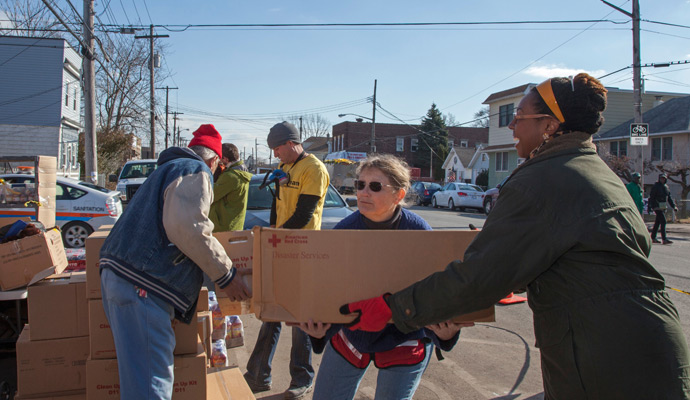Sidestepping Disaster
Extending supply chains to low-cost nations may make economic sense, but disruptions from natural catastrophes can drown the gains.
(originally published by Booz & Company)When a severe earthquake ripped through China’s Sichuan Province this spring, Greg Hayes, one of United Technologies Corporation’s (UTC) two chief financial officers, was worried that the company’s facilities in the region would be damaged so severely that UTC’s bottom line would take a hit. He was particularly concerned about the conglomerate’s factories in Chengdu, a thriving business hub in Sichuan, which make Otis elevators, Carrier air-conditioning equipment, and Pratt & Whitney engine components.
Hayes’s worries were quickly alleviated, however. “I got calls from each of the three businesses, saying, ‘Look, we’ve had a little bit of damage. But our people are okay,’” says Hayes. “And despite all the devastation, they had all the factories up and running within a week and the costs to the company were minimal.”
UTC survived the disaster virtually unscathed, primarily because each business had a continuity team with a contingency program for responding to emergencies. Otis’s plan, for example, called for its factories in Tianjin, a large port city near Beijing, to make up for disruptions in Sichuan — a plan that ultimately was not needed because of the Sichuan factory's fast recovery.
Many major U.S. companies with extended global supply chains are confronting similar challenges, which stem from an increasing number of weather-related and natural disruptions. Some experts blame global warming for what seems to be a growing prevalence of natural disasters. That may or may not be the culprit, but multinationals are clearly exacerbating the impact of these calamities by moving their supply bases deeper into lower-cost countries such as Vietnam, Cambodia, and Bangladesh in hopes of minimizing manufacturing expenses. Such regions are vulnerable to massive storms, flooding, and earthquakes, and their high population density and relatively undeveloped infrastructures compound safety, medical, and transportation challenges during a catastrophe.
The most obvious antidote to supply chain disruptions was the one employed by UTC: Build redundant manufacturing capability. That approach doesn’t merely entail having a second plant ready in a safe region for when it is needed, it also requires putting online multiple factories that make the same components as a routine course of business. Currently, about 27 percent of UTC’s suppliers are in low-cost locations such as China, India, and Eastern Europe. But the company is aiming to increase that number to closer to 50 percent — anything higher than that would make UTC overly dependent on those locations, says Hayes. With this plan, UTC hopes to “split its buy” between traditional sourcing locations and low-cost countries. “We want to have dual sourcing so that we are never held hostage by one location or one supplier,” Hayes explains.
Other companies are proactive in different ways. For example, The FedEx Corporation monitors weather patterns for key customers and asks them if they want to pre-position inventory in FedEx warehouses near end-users when a disruption appears imminent. This practice, which Tom Schmitt, chief executive officer of FedEx’s global supply chain services unit, calls “forward deployment,” allows companies to be more impervious to bad weather. Customers such as hospitals have come to rely on that forward deployment. Says Schmitt, “If a mechanical device goes out at a hospital in the middle of a storm, no matter where the hospital is located, they need a way to get a replacement in a hurry.”
Another element of preparation is to inspect each tier of a company’s supply chain to ascertain whether suppliers have built facilities that will withstand flooding, earthquakes, and windstorms. Shivan Subramaniam, chairman and CEO of Rhode Island–based FM Global, which insures the supply chains of large companies, says some companies make sure that their suppliers in China are lodged in buildings that can withstand snow and wintry conditions; these companies avoided disruption when large parts of central China were hit by blizzards this past winter.
One basic precaution, Subramaniam says, is ensuring that goods are stored on a second floor in a fortified structure, safe from the elements during a hurricane or a flood. “If multinationals can’t change where they are making products or where they are warehousing them, they can at least bring to bear loss-prevention techniques so that when the wind does blow, they know the building will remain intact,” he says.
The companies that face the most difficult issues are those with less control over the placement and robustness of their critical facilities. For example, electronics manufacturers like Hewlett-Packard, Dell, and Cisco Systems typically depend on an outsourced manufacturer — Flextronics is a well-known one — to make and assemble large components in their products. These contract manufacturers have another tier of suppliers beneath them and then at least one more tier below that. “You can have a high-tech product from Dell or HP, but actual manufacturing gets done by Flextronics, which turns to other people who are not on their payroll,” says FedEx’s Schmitt. “The further you get down that chain, the further away it is from the United States.”
Adding to the complexity is the fact that the large electronics companies are taking the products manufactured by a distant supply chain and distributing them all over the world. Some experts recommend that companies relying on contract manufacturers can, if nothing else, stipulate in their agreements that losses will be shared in the event of a natural disaster that disrupts the flow of supplies.
Information technology systems that support global supply chains must also be considered when planning for natural disruptions, says Subramaniam. It’s one thing to safeguard physical production, warehousing, and transportation, but if IT systems are knocked out, companies lose the ability to manage their supply chain and engage with customers. Customer-specific data is particularly important to safeguard. “Every major organization is looking at how it can back up the data centers, which represent the ability to service clients,” Subramaniam says.
A potentially salutary by-product of the growing fear of natural disruptions is a new willingness among companies and their suppliers to exchange detailed information about what is happening throughout the supply chain, using software tools that enable collaborative decision making and that in many cases can lead to increased efficiency between trading partners, says Leroy B. Schwarz, professor of management at Purdue University. By making commodities, logistics, procurement, and pricing information more transparent, affiliated companies can come to the aid of a supplier or sub-supplier that suddenly loses access to raw materials or has its distribution network curtailed by an unexpected event before a bottleneck is created.
Whether or not one subscribes to the theory of global climate change, the expansion of supply chains into new geographies means that companies must continue to educate themselves about natural disruptions — and spend a bit more money to build redundant factories, weatherproof their facilities, and pre-position inventory. Despite the heightened risks, however, Schwarz says companies see such large cost gains from extending their supply chains into lower-cost countries that “nothing is stopping the trend.”![]()
Author profile:
William J. Holstein is a veteran business journalist and author based in New York. For more of his work, visit www.williamholstein.com.




